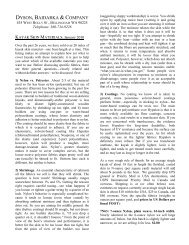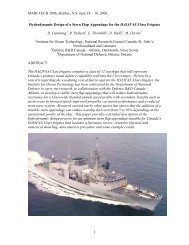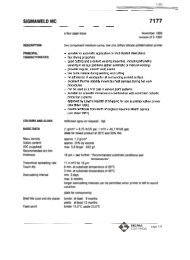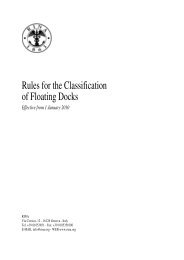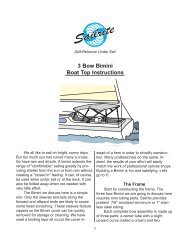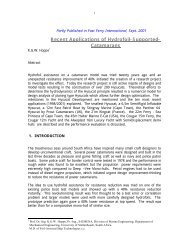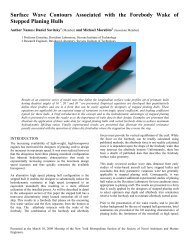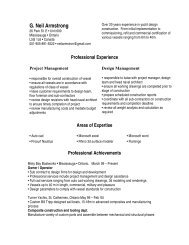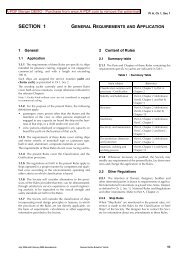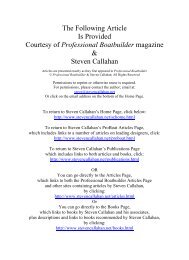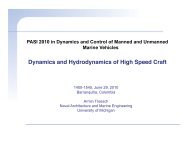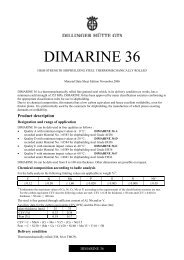RULES DET NORSKE VERITAS (DNV) = STRUCTURES = - Boat Design Net
RULES DET NORSKE VERITAS (DNV) = STRUCTURES = - Boat Design Net
RULES DET NORSKE VERITAS (DNV) = STRUCTURES = - Boat Design Net
Create successful ePaper yourself
Turn your PDF publications into a flip-book with our unique Google optimized e-Paper software.
Amended July 2011, see page 3 Rules for High Speed, Light Craft and Naval Surface Craft, January 2011Pt.3 Ch.3 Sec.6 – Page 31Table A2 Values of t 0 and kItem t 0 kBottom centre girder 3.0 0.05Bottom side girders, floors, brackets and stiffeners 3.0 0.03Girders and Side, deck and bulkhead longitudinals girders and stiffeners outside the peaks 3.0 0.02stiffenersPeak girders and stiffeners 3.0 0.03Longitudinals 3.0 0.03Double bottom floors and girders 3.0 0.02Other structuresFoundations 3.0 0.08Structures not mentioned above 3.0 0A 400 Allowable stresses401 Maximum allowable bending stresses and shear stresses in web frames and girders are to be accordingto Table A3.Table A3 Allowable stressesItemWeb frames and girdersBending stress(N/mm 2 )Shear stress(N/mm 2 )Equivalent stress(N/mm 2 )Dynamic load 180 f 1 90 f 1 200 f 1Sea/static load 160 f 1 90 f 1 180 f 1For watertight bulkheads (excluding the collision bulkhead), allowable stresses may be increased to 200 f 1 , 100f 1 and 220 f 1 for bending, shear and equivalent stresses, respectively.A 500 Continuity of strength members501 Structural continuity is to be maintained at the junction of primary supporting members of unequalstiffness by fitting well rounded brackets.Brackets are to extend to the nearest stiffener, or local plating reinforcement is to be provided at the toe of thebracket.502 Where practicable, deck pillars are to be located in line with pillars above or below.503 Below decks and platforms, strong transverses are to be fitted between verticals and pillars, so that rigidcontinuous frame structures are formed.B. Web Frames and GirdersB 100 General101 The requirements for section modulus and web area given in 400 are applicable to simple girderssupporting stiffeners or other girders exposed to linearly distributed lateral pressure. It is assumed that thegirder satisfies the basic assumptions of simple beam theory and that the supported members are approximatelyevenly spaced and similarly supported at both ends. Other loads will have to be specially considered.102 When boundary conditions for individual girders are not predictable due to dependence of adjacentstructures, direct calculations according to the procedures given in Sec. 9 D will be required.103 The section modulus and web area of the girder are to be taken in accordance with requirements as givenin the following. Structural modelling in connection with direct stress analysis is to be based on the samerequirements when applicable. Note that such structural modelling will not reflect the stress distribution at localflange cutouts or at supports with variable stiffness over the flange width. The local effective flange which maybe applied in stress analysis is indicated for construction details in various Classification Notes on «strengthanalysis of hull structures)».B 200 Effective flange201 The effective plate flange area is defined as the cross-sectional area of plating within the effective flangewidth. Continuous stiffeners may be included with 50% of their cross-sectional area. The effective flange widthbe is determined by the following formula:b e = C b (m)C= as given in Table B1 for various numbers of evenly spaced point loads (r) on the span.<strong>DET</strong> <strong>NORSKE</strong> <strong>VERITAS</strong> AS



